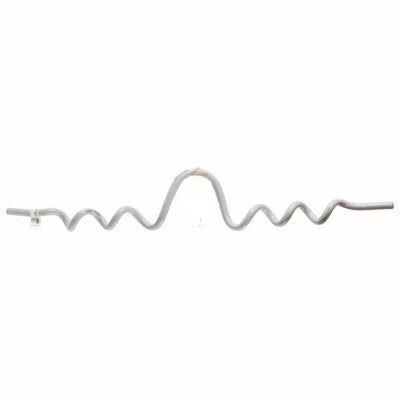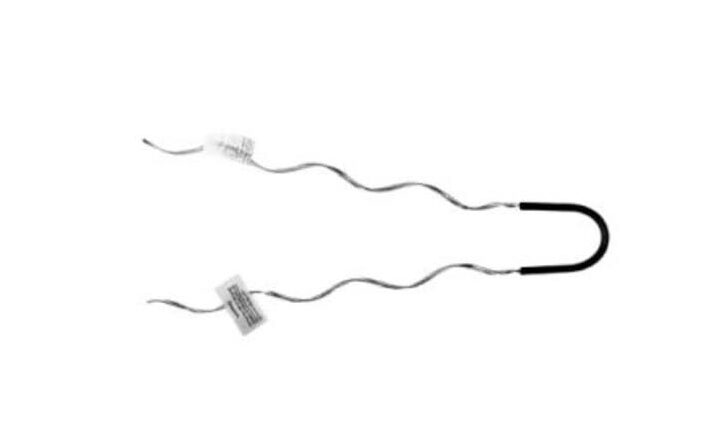
A top tie is a component that secures the conductor to the insulator of a crossarm or support structure. The top tie keeps the conductor in place on the insulator even while under environmental stress. Their structure enables them to accommodate certain conductor sizes and insulator configurations. The top tie also includes a layer of protection to keep the conductor and insulator safe.Proper top tie tension decreases sag while maintaining the desired ground clearance. Top ties are available in a variety of styles and materials to accommodate different types of conductors. Preformed ties, hand knotted, and armor rods are all common materials. They are from a variety of materials that have high tensile strength, can sustain mechanical stress, and are corrosion resistant. These materials include galvanized steel or aluminum alloys.
The essential components of the top tie
A top tie comprises up of many parts that work together to bind a conductor to an insulator. The components ensure that the conductor remains in place, hence maintaining the transmission line’s integrity and safety. Each of these components contributes significantly to mechanical stability, electrical insulation, and durability. The top tie has the following common components.

- Helical rods – preformed rods wrap around the conductor to provide a secure and distributed grip. They reduce stress on the conductor to help absorb mechanical vibrations.
- Cushioning layer – this protects the conductor from damage due to direct contact with the tie wire. It also helps in dampening vibrations and absorb the impact. It is from materials such as rubber, polymer and other insulating materials.
- Insulating components – these ensure the electrical insulation between the conductor and the wire. This is to prevent electrical leakage and maintain system integrity. They are from non-conductive materials like polymers or ceramics.
- Armor rods – these provide extra mechanical support and protection for the conductor. They also distribute mechanical loads to protect the conductor from wear and abrasion.
- Tie wire – this is the main component that secures the conductor to the insulator. It wraps around the conductor and insulator to hold them in place. It is from materials such as aluminum-clad steel, galvanized steel or aluminum.
- Binding straps – these help to fasten the tie wire around the conductor and insulator. They ensure the tie remains in place and does not loosen over time.
- Preformed ends – preformed ends have designs to fit specific conductor and insulator profiles. This helps to ensure a snug and secure fit for easy installation.
- Locking mechanisms – the mechanism provides a secure attachment point and prevents the tie wire from unravelling.
Attributes of the top tie:
Top ties for transmission lines have specific features to ensure it secures the conductors to insulators. This helps to maintain the system integrity and performance. These features are able to withstand environmental and mechanical stresses for easy installation. Understanding these features helps to ensure proper selection of the top ties. The following are the common features of the top tie.

- Mechanical strength and durability – top ties are from materials that provide high tensile strength to withstand the mechanical stresses. The materials include galvanized steel or aluminum alloys that are resistant to corrosion.
- Ease of installation – most of the top ties are available in preformed shapes to ensure easy installation. They are also available in different sizes to match different conductors and insulators.
- Conductor and insulator compatibility – top ties have designs to for specific conductor sizes. They also have protective cushioning to prevent damage to the conductor and insulator.
- Secure conductor attachment – the top ties have designs to provide a strong and reliable grip on the conductor. They have designs to prevent conductor slippage especially under varying weather conditions.
- Vibration dampening – they also have features that absorb and reduce vibrations caused by wind or other factors. Vibrations can lead to fatigue and wear of the conductor and insulator.
- Weather resistance – top ties have designs to perform in a range of environmental conditions. The materials used are also resistant to UV light which increases durability.
- Electrical insulation – most of the top ties are able to maintain the insulative properties of the assembly. This is to ensure there is no electrical leakage at the point of contact.
- Compliance with standards – manufacture of top ties should follow industry standards and regulations.
Several varieties of available top ties
There are various types of top ties that serve unique purposes in overhead transmission lines. The type of tie chosen depends on the conductor, insulator, and mechanical loads. Each form of top tie has certain characteristics that make it appropriate for various uses. The following are the most frequent types of top ties used in overhead transmission lines.

- Wraplock ties – these help to secure the conductors to pin type insulators for secure grip and flexibility. They consist of a metal wire that wraps around the conductor and the insulator. They also provide a firm grip on the conductor and are suitable for various conductor sizes.
- Armor grip ties – these provide extra protection and support for the conductor. This makes them suitable for areas with high mechanical stress. They include rods that wrap around the conductor to distribute mechanical loads.
- Hand ties – these are traditional ties that wrap around the conductor manually. They can be custom-fitted to unique configurations and allows for adjustments during installation.
- Composite ties – these ties use a combination of materials to provide enhanced performance. They provide a balance of strength and insulation and are best in corrosive environments.
- Twisted pair ties – these use two wires twisted together to secure the conductor to the insulator. They provide a robust and secure grip and are suitable for various conductor sizes and applications.
- Preformed top ties – these are often used due to their ease of installation and consistent performance. Their preformed design allows them to fit specific conductor sizes and insulators. They are easy to install, provide a reliable grip and reduces the risk of conductor damage.
Advantages of installing top ties in overhead transmission lines
The use of top ties in overhead transmission lines has various advantages that improve the safety and reliability of power networks. Top ties improve the cost-effectiveness and reliability of the electricity transmission network. This works by minimizing maintenance requirements and extending the life of transmission line components. The following are the advantages of installing top ties in overhead transmission lines.

- Improved mechanical strength – the ties distribute mechanical loads across the conductor and insulator. This reduce the stress on individual components and prevents localized wear. Also, top ties provide a connection that can withstand adverse weather conditions.
- Increased electrical safety – top ties help maintain the electrical insulation. This helps to prevent short circuits and electrical leakage. Additionally, they keep the conductor aligned and separated from other conductors and structures.
- Reduced maintenance requirements – the ties are from durable and corrosion resistant materials that reduce need for maintenance. They provide reliable performance over long periods which lowers the maintenance costs.
- Enhanced conductor stability – top ties attach the conductor to the insulator to prevent slippage. They also help reduce vibrations from wind and other environmental factors.
- Cost effectiveness – the ties provide durability that saves on labor and material costs over time. This is from the ease of installation and standardized designs of the ties.
- Ease of installation – many top ties are easy to install which requires less time and skill compared to other methods.
- Enhanced system reliability – the secure attachment helps maintain the integrity of the electrical transmission system. The ties provide a stable and reliable connection that is less prone to failure.
Problems and challenges regarding the use of top ties
Using top ties in overhead transmission lines has many benefits. There are other issues that affect the use of top ties. Additionally, addressing these problems is critical to ensuring their effectiveness in overhead transmission lines. The following are the most prevalent issues associated with top tie use.

- Corrosion and environmental degradation – exposure to harsh environmental conditions can cause corrosion of metal top ties.
- Installation challenges – the right tension is critical for ensuring a secure fit without damaging the conductor.
- Mechanical stress and fatigue – top ties face mechanical stress from high wind loads which lead to failure.
- Compatibility issues – top ties must be compatible with a wide range of conductor sizes and insulator designs.
- Electrical issues – some top ties must ensure they do not interfere with the coating or layers. Poor installation of top ties can lead to electrical leakage.
- Thermal expansion and contraction – changes in temperature can lead to loosening of the top tie or increased mechanical stress.
Frequently asked questions
A top tie is a hardware used to secure a conductor to an insulator in overhead transmission lines. It helps to maintain the position and alignment of the conductor and ensure stable and reliable electrical transmission.
If a top tie fails, the conductor could become loose or fall from the insulator, causing electrical faults, outages, and dangerous situations. To ensure the transmission line’s integrity, any broken or failing top ties needs immediate replacement.
Top ties are from materials such as aluminum, galvanized steel and composite materials.
